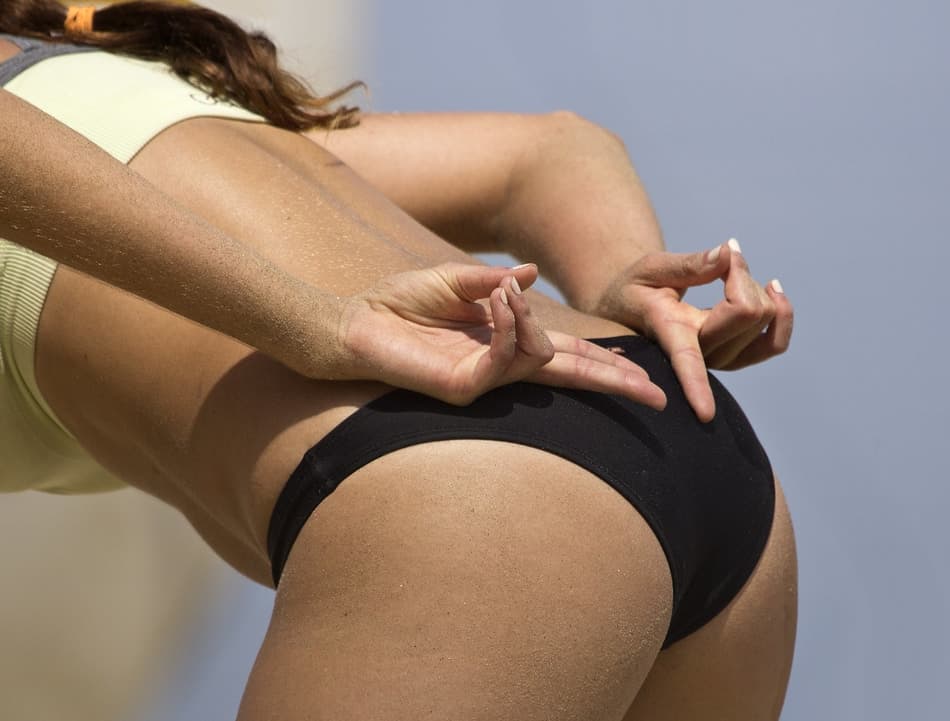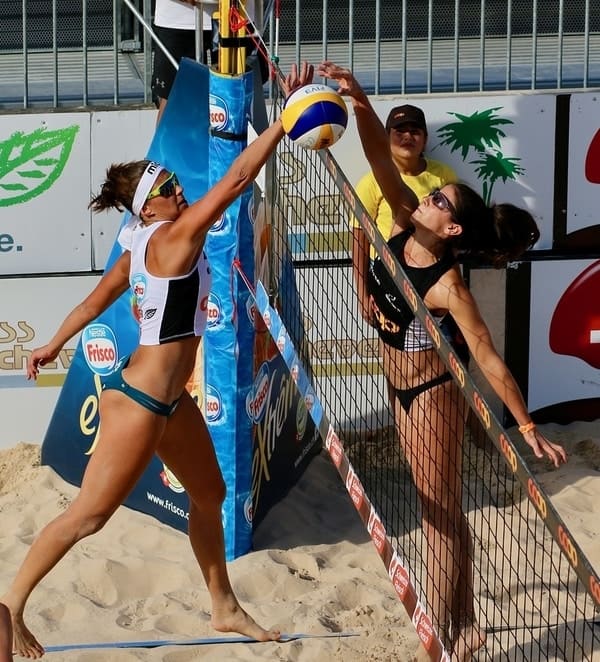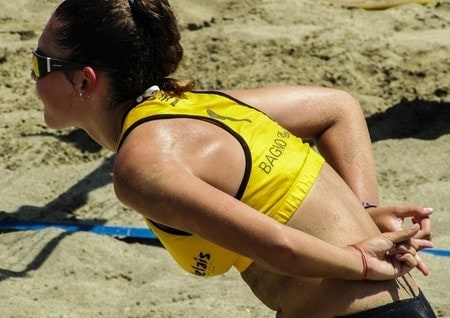After watching beach volleyball for years, I finally had to ask – what in the world do the finger signals mean? I had seen it over and over and new the players were telling their teammate something, but what on earth could they see that their teammate could not? The answer is simple… sort of.

Like most things in sports, there’s a twist on everything. Whether you’re watching the Olympics, an AVP tour game, or even a competitive game on the local sandy shores, you may be noticing they’re using signals to strategize.
Everyone has their own versions and secret add-ons. But we’ll start with the basic concepts and you can have fun watching the teams make their calls and seeing how they add their own codes.
Beach Volleyball Hand Signals
The main signals are divided into 2 groups; the blocking signals and the serving signals. Since you want to keep your signal hidden, the player closer to the net will be signaling, usually behind their back or butt so that the other team can’t see.
Remember in beach volleyball there’s just 2 of you, so you HAVE to work together! Even if you don’t agree with your teammate, when he or she makes the call, you’ve got to play along. They’re counting on you to go with their plan.
On the beach, blocking is so different because you’ll never be blocking with teammates. In indoor volleyball, it’s very common to have double and triple blocks. That’s why signals are so critical, your teammate needs to know where you’re going to defend.
Beach Volleyball Blocking Signals
The most common blocking signals:
| 1 Finger | I’m going to block line, you defend angle. |
| 2 Fingers | I’m going to block angle, you defend the line. |
| 3 Fingers | I’m going to fake angle, but block line. |
| 4 Fingers | I’m going to fake line, but block angle. |
| Closed Fist | Either means we’re not going to block, just pull off and play defense, OR I’m confident I’m going to block straight on, you dig whatever gets past me. |
| Open Hand | Either I’m going to block the hitter straight on OR I’m ready to defend this side if they play the ball over in 2 hits. |
| Pointing Thumb | This usually shows the server which side you’d like them to serve to. |
| Signal High on Back | Indicating a possible backset coming and how you will play it. |
| Fist with Pinky Out | I’m going to block, but be ready to come around and defend beside my block. |
Blocking Line

To say you’re blocking line means you will defend the space along the sideline of the court. You’re going to stop the attacker from being able to spike the ball down the line, forcing them to either hit towards the center of the court or play the ball high over your block. You will face up against the hitter and then shift just slightly closer to the nearest sideline and use your arms to box them in so they have to play it across.
With the single finger or the 3 finger calls, the individual finger should be pointing to the line they are defending. They will usually use the hand of the opposite side to point at a downward angle.
Blocking Angle
Blocking angle means defending the center of the court, forcing your opponent to hit down the line or play the ball high over your block. When you call angle, you will face up against your opponent and then shift just slightly towards the middle of the court and use your arms to block off the angle shot.
Faking Your Block
If you just play straightforward all the time, you become predictable and your opponent will start to read your body language and know how to attack you before you jump. So it’s important you mix up your moves.
To fake your opponent, sometimes you will want to make it seem like you’re doing one thing and then at the last second, quickly adjust and switch your block. This is also called baiting the hitter.
You may make the line seem open and then twist outside to block line at the last second. Or vice-versa with the angle block.
You will see many variations that are added or modified by different teams. Professional teams will change up their signaling if they ever feel like they’re being watched and someone is passing signals to the other team.
If you would like to learn about blocking in volleyball, take a few minutes to read Six Steps To Dominate In Volleyball With Incredible Blocking.
Beach Volleyball Serving Signals

When players are signaling where to target for the serve, the signals can be complex or they can be as basic as right side of the court/left side of the court.
Some teams will simply flash their right or left hand indicating which side they’d like the ball to go. Others may only use the hand of the side they want the serve to go to.
Some other variations you may see:
| Two fingers back | The flashing fingers show which side to target. |
| Two fingers staggered | The top one indicates side to serve to, the bottom indicates how deep or short to aim. |
| Two fingers close in the center | This means I will back off the net after the serve and we’ll play defense. |
Hopefully, now you’ll enjoy knowing a little more about the gamesmanship that’s going on between points.
When your family and friends are gathered for the Gold Medal Match at the Summer Olympics and they’re all wondering, you can drop a little knowledge on them. Don’t read them the whole list, just mention one or two casually, and leave them wondering how you know so much!
If you would like to learn more about beach volleyball, visit our category page for all the beach volleyball topics we’ve written about.
Photo Credits:
Feature image by Michael Dorausch on flickr.com: https://creativecommons.org/licenses/by-sa/2.0/
Hand signals image by C Watts on flickr.com: https://creativecommons.org/licenses/by/2.0/, cropped to center the image.
Blocking line image by H. B. from Pixabay
Serving signal image by Dimitris Vetsikas from Pixabay.
Recent Posts
Athletes, listen up! Do you have a closet full of old jerseys, sweatpants, and tees that you just can't seem to part with? Well, dust them off, because you're sitting on a goldmine of fashion...
You may have heard, or you may have noticed, that there's been a change to the rule about double contact in volleyball. In 2022, an experimental rule change began to be implemented, where the double...
